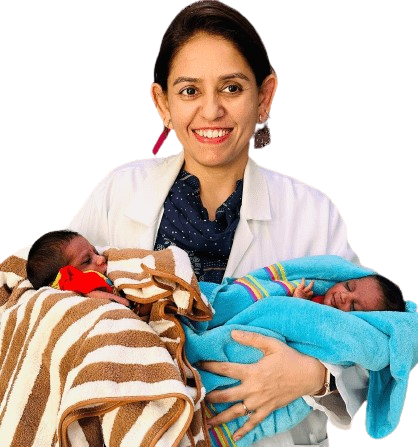
IVF : In-vitro fertilization
In-vitro fertilization (IVF) is a medical procedure that involves retrieving eggs from the ovaries of a woman and fertilizing them with sperm in a laboratory. The resulting embryos are then transferred to the uterus of the woman, where they can implant and develop into a pregnancy. IVF treatment has helped many couples overcome infertility issues and achieve their dreams of having children. It is one of the most successful treatments for infertility, with success rates ranging from 30-60%, depending on various factors such as age, lifestyle, and health. IVF treatment can be used to treat both male and female infertility problems such as low sperm count or blocked fallopian tubes. Additionally, it can also be used to help same-sex couples have children using donor eggs or sperm
Why is IVF performed?
- Blocked or damaged fallopian tubes: Fallopian tube damage or blockage makes it difficult for an egg to be fertilized
- Endometriosis: When tissue similar to the lining of the uterus implants and grows outside of the uterus.
- Low sperm count: Oligozoospermia a low sperm count, is a condition where a man has fewer than 15 million sperm per millilitre of semen.
- PCOS: Polycystic ovary syndrome (PCOS) is a condition in which the ovaries produce an abnormal number of androgens, male sex hormones that are usually present in women in small amounts.
- Uterine fibroids: non-Cancerous growth of benign tumors in the uterus. Women in their 30s and 40s is a common age group where uterine fibroids may occur.
- Unexplained Infertility: no cause of infertility has been found despite evaluation for common causes. Couples may have problems with Egg Quality, tubal Function, or sperm function that are difficult to diagnose.
How long is the IVF process from beginning to end?
IVF is a complicated process with many steps. On average, you can expect the process to last four to six weeks. Time includes before egg retrieval, when a person takes fertility medication until they’re tested for pregnancy.
What are the steps of IVF treatment?
- Ovarian stimulation: Fertility treatment for women in which the ovaries are stimulated to produce two or three eggs, in the hope that one of these will mature to become suitable for fertilization.
- Egg Retrieval: Transvaginal ultrasound aspiration is used to retrieve eggs. an ultrasound probe is inserted into your vagina to identify follicles, and a needle is guided through the vagina and into the follicles. The eggs are removed from the follicles through the needle, which is connected to a suction device.
- Fertilization: The sperm from a male meets an ovum from a female and forms a zygote; this is the point at which pregnancy begins and leads to a 280-day journey for a female.
- Embryo development: It is a process of developing an embryo into a foetus during gestation. After the eggs are collected, sorted, and prepared, the embryologist, begins the fertilization process in the ART lab.
- Embryo transfer: It is a simple procedure that takes about five minutes, with no anaesthesia or recovery time needed. Assisted reproduction in which embryos are placed into the uterus of a female with a help of catheter with the intent to establish a pregnancy.
How to prepare for IVF treatment?
- Eat a healthy, well-balanced diet.
- Start taking prenatal vitamins.
- Maintain a healthy weight.
- Stop Drinking Alcohol, Stop Smoking, and Recreational Drugs.
- Reduce or eliminate your caffeine intake.
What is the success rate of IVF according to age?
- Women younger than 35 years of age: 40%
- Women aged 35 to 37: 27%
- Women aged 38 to 40: 18%
- Women aged 41 to 44: 12%
- Women aged Above 44: 3%





